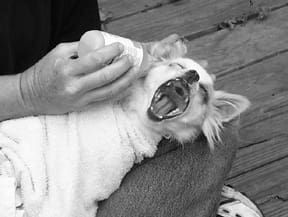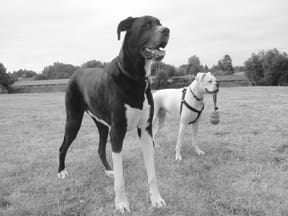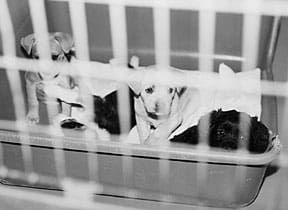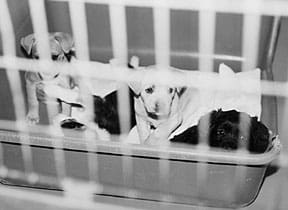[Updated January 10, 2019]
DOG EARS OVERVIEW
What you can do…
1. Frequently inspect your dog’s ears. Take a peek in there at least once a day. Investigate any abnormality quickly; ear problems can become dramatically painful with rapidity.
2. Solving chronic ear problems requires a body-wide treatment, including improvements to diet. Start with a thorough physical at your holistic veterinarian’s office.
3. While holistic home care is best for preventing ear problems, quick conventional veterinary diagnosis – and sometimes, treatment – may be needed to effectively treat a serious problem.
In many ways it could be said that a dog “leads with its ears.” A dog’s ears are right up front, one of the most noticeable parts of his anatomy, and they are a conspicuous visual reminder that demonstrates and carries much of his character and personality. From the veterinary standpoint, the ears are a good place to begin a physical exam to check for both specific and general diseases.
The shape of the ear is characteristic of the breed, and there are many types of outer ears: large and drooping, as in the Bloodhound or Cocker Spaniel; erect and mobile, as in the German Shepherd or Border Collie; or small and button-like as in a Bulldog or Chinese Shar Pei.
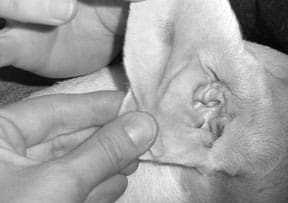
The way a dog carries his ears gives us an insight into how he is feeling physically and emotionally, and the “posture” of the ears is a language unto itself. In other words, by observing the carriage of a dog’s ears, we are given a way to “hear” what he is trying to tell us. In addition, abnormal carriage of the ears may indicate disease or nerve damage, and abnormal ear size (for the breed) may be an indication of multiple genetic defects.
The ear can be divided into four parts: ear flap (auricle or pinna); external ear canal (external auditory meatus); middle ear; and internal (inner) ear. The pinnae are highly mobile and can be controlled independently. More than a dozen separate muscles control the movement of the ear, and the entire area is richly supplied with blood vessels and nerves.
The pinna of the external ear is a funnel-like plate of cartilage that receives air vibrations and transmits them via the ear canal to the eardrum (tympanic membrane).
The ear canal is lined with both apocrine (ceruminous) and sebaceous glands which, in the normal animal, produce a protective coating of earwax (cerumen). In chronic otitis the sebaceous glands become fewer than normal, and the apocrine glands increase in number, in size, and in their production of secretions.
Note that the dog’s ear canal is considerably longer than its human counterpart, and after extending downward, it makes a sharp turn inward toward the eardrum. Thus, complete examination of the ear canal requires an otoscope with special (long and thin) cones. Few dogs tolerate anything being poked into the external ear canal, and dogs with painful ears (from infections or foreign bodies) almost never allow adequate examination without anesthesia.
The eardrum separates the external ear from the middle ear, and it is the area where vibrations sent from the external ear are focused and amplified. There are three small bones within the middle ear – the malleus, incus, and stapes – that transmit the vibrations from the eardrum to the inner ear.
The inner ear consists of two main parts: the cochlea (end organ for hearing) and the vestibule and semicircular canals (end organ for balance). All these can be thought of as a series of tunnels or canals within the temporal bone. Inside the cochlea are specialized hair cells that pick up auditory vibrations and synapse directly with the auditory nerve.
Equilibrium is controlled by electrical impulses that are registered on hair cells located in the three semicircular canals. These signals transmit the current status of the body (head) in relation to the horizon (gravity).
The ear has two functions – hearing and balance – and either function can be disturbed by disease, old age, or nerve disruption from a number of causes.
What a Dog Hears
Hearing can be visualized as waves of energy traveling along molecules in the air, transformed into mechanical energy at the ear drum, then amplified by small bones and finally transformed into the electrical impulses in the auditory nerve – resulting in what the brain registers as hearing.
Dogs have a much different range of hearing than ours, extending into a considerably higher frequency than we can hear. Sound frequency, the number of sound wave cycles every second, is measured in Hertz (Hz). The higher the frequency, the more sound waves per second, the higher-pitched the sound. Humans hear best at around 2,000 Hz; dogs hear best at 8,000 Hz – perhaps the reason they respond better to high pitched cues.
Dog Ears According to Traditional Chinese Medicine
While Western medicine views the ears from the functional standpoint of hearing and balance, Traditional Chinese Medicine believes that the ears are connected to the Kidney Organ system. Poor hearing, common in the elderly patient, is thought to be a consequence of weakened Kidney Jing. (Jing is best translated as the essence or the substance that underlies all organic life.)
Thus, acupuncture practitioners will often treat hearing problems by needling acu-points related to the Kidney. In addition, both the Triple Burner and Gall Bladder meridians pass through the ears and are said to control them, so points related to these meridians may be added to an acupuncturist’s therapeutic protocol.
A system of “auricular acupuncture” has been developed that relies on needles inserted into specific parts of the ear to treat other anatomical parts of the body.
Mild Solutions for the Basically Healthy Ear
1: Squirt about a teaspoon of hydrogen peroxide (the 3% type) in each ear. Let the dog shake and wipe off the excess.
2: Mix 1 cup water, ½ teaspoon sea salt, 1 teaspoon tincture of calendula, if desired. Warm to 101 degrees F. Gently flush using an ear syringe.
3: Mix 3 drops white vinegar with enough pure water to fill a one-ounce dropper bottle. Warm the solution to 101 degrees. Add about six drops per ear. Note: This should feel good. If the ear is inflamed, it may hurt. If pain is evident, dilute with water by half. If the dog still objects, use the calendula formula above.
4: For an acidophilus treatment, start by cleaning the dog’s ears. Mix the contents of one capsule of powdered acidophilus into an ounce of pure water, or use dilute a small amount of liquid acidophilus with water. Pour this solution into the ear. Allow the dog to shake his head, but leave the residue in the ear. Since the ear canal is not a normal habitat for them, the acidophilus organisms will eventually die. (The acidophilus organisms compete with other yeasts, and eventually kill them.) This treatment can be repeated periodically.
5: Almost any herb with antimicrobial, anti-inflammatory, and/ or immune-boosting activity can be used for the main part of an herbal wash, but mullein, marshmallow root, calendula, chamomile, lavender, and Oregon grape root are excellent choices. Use the active part of the herb (for example: marshmallow root, mullein flower, which can be harvested along with the mature cob) and cover several ounces of this with pure, organic almond or olive oil. Let this mixture sit for several days. Strain it, and use the strained oil, several drops per ear.
Herbal mixtures may contain one herb or several. For additional antibiotic activity, you can add a clove or two of garlic to the original mixture. If inflammation or swelling is present, mix with equal amounts of distilled liquid witch hazel. Add several drops of liquid vitamin E per ounce of fluid as a preservative and keep in a cool, dark place. Make and use a fresh mixture after a week or two.
6: To treat a mite infestation, use a simple soothing oil applied directly in the ear canal. Repeat every three days for four to six weeks. Mullein has insecticide activity and can be added to the oil mixture; other herbs may also be helpful, including: yellow dock (Rumex crispus), thyme (Thymus vulgaris), rue (Ruta graveolens), or rosemary (Rosemarinus officinalis). The high sulfur content in garlic may be helpful in killing mites.
There are dozens of commercial ear care products, many of which are “natural.” My favorite has long been Halo’s Ear Wash product – several herbs in a witch hazel base. I’ve heard good things about DermaPet’s Ear/Skin Cleanser, which is a two percent vinegar, two percent boric acid solution. Animals’ Apawthecary has a nice product (Herbal Ear Rinse) which contains cider vinegar, aloe vera juice, vegetable glycerin, witch hazel, organic goldenseal root, calendula flowers, and olive leaf.
Natural Ear Care for Dogs At Home
There are numerous methods of natural care that the dog owner can use to keep her dog’s ears and hearing healthy:
Food for Ears
When we put together a diet to aid in the prevention and treatment of problems located in or around a dog’s ears, it is important to remember that many ear infections are associated with allergies. Choose high-quality foods that do not contain artificial preservatives, flavorings, or food colorings. Consider making a home-prepared diet, or if this is not feasible for you, move up to a higher-quality diet.
If your dog experiences chronic ear infections – and especially if the infections are associated with obvious symptoms of allergies, consider performing a food-elimination trial to investigate particular foods as a potential cause of the allergies.
Antioxidants are crucial for the effectiveness of the immune system, and they will aid circulatory and nerve health in the area of the ears. Consider supplementing your dog’s diet with antioxidants such as vitamins A and E, Coenzyme Q-10, or any number of the culinary herbs, including rosemary (Rosmarinus officinalis), thyme (Thymus vulgaris), and oregano (Origanum vulgare). Ginkgo (Ginkgo biloba), is high in antioxidant activity and has specific beneficial effects to the ear.
Zinc quickens the immune response; vitamin C is needed for proper immune function. Vitamin B complex is essential for healing and has been shown in humans to reduce ear pressure. Potassium helps maintain nervous system health and nerve impulse transmission. In humans, manganese deficiency has been linked to ear disorders.
Ear infections may be linked to hypothyroidism, so you may want to have your dog’s thyroid checked. If the test results suggest hypothyroidism, add to the diet one of the seaweed herbs such as bladderwack (Fucus vesiculosus), dulse (Palmaria palmate), or kelp (Laminaria spp.). Siberian ginseng (Eleutherococcus senticosus) is a good, non-specific herb that offers whole-body adaptogenic qualities that strengthen and balance all organ systems.
Your holistic practitioner can be of invaluable help in this area of supplements. She can help you select foods or products that contain the needed supplements, and she can help you calculate dosages that are appropriate for the weight of your dog and his current condition. (Preventative dosages, for example, are much less than those used to treat an ongoing disease.)
Most importantly, she can help you select a product and dosage protocol that provides enough of the supplement without creating imbalances and/or potentially toxic levels of any one supplement.
It’s very typical for a client to bring me a shopping bag full of supplements. When we read the labels and calculate the dosages, we invariably find duplications of many of the supplements. We almost always toss out about half of the supplements in the bag, and we’re still able to provide all the necessary supplements in appropriate dosages.
Ear Washes
There are several natural solutions that can be used periodically to “wash” or “irrigate” a dog’s ears – to help maintain the normal flora of the ear, and thus help prevent ear diseases. Pour several teaspoons of the solution into your dog’s ear, gently massage around the base of the ear, and then (after he shakes his head) wipe off the excess fluids with a clean cloth.
How often you use an ear wash depends on the environment of your dog’s ear. Long, floppy ears tend to trap moisture, which provides an ideal growing place for microorganisms; small, upright ears that allow plenty of air circulation tend to stay cleaner and infection-free.
To prevent disease from occurring in the floppy-eared dogs, you may need to wash once a week; once a month is probably plenty for a prick-eared dog. When you treat disease, begin with treatments three or four times a day and taper off as the disease resolves.
General rules for ear washes: One of our goals is to keep excess wax and oil from building up and obstructing the ear canal – a simple saline mixture or dilute vinegar wash may be adequate for this. Herbal preparations often have many simultaneous benefits: they ease pain and are calming, many are anti-inflammatory, and most are antimicrobial, typically effective against a wide range of bacteria, yeasts, and fungi.
One of the most common pathogens found in chronic ear infections is a yeast, Malassezia pachydermatis (syn. Pityro-sporum canis). This yeast is one of those oddball bugs; low numbers are normally found in healthy ears, but they can become pathogenic (cause disease) under certain conditions.
The idea is to keep the numbers of Malassezia down, and there are several ways to do this. An acid environment discourages their growth – occasionally use a dilute vinegar wash. Bacteria thrive in an oily, waxy environment, so keep the ear canal clear of excess wax and oil buildup. Many herbs have anti-yeast properties (See herbal section for more information). Acidophilus directly competes with yeasts, and an occasional lactobacillus “ear irrigation” will keep the yeast numbers down.
Ear Massage
There’s almost nothing that will endear you more to your dog than a daily ear massage. (Well OK, a timely food dish may be a little more endearing.) It’s not just that dogs love the ear massage, you’ll be helping improve blood and nerve supply to the region and, according to auricular acupuncture theory, you’ll be enhancing all the Organ systems of the body simultaneously.
A good ear rub is easy to master, too. Simply rub gently around the entire base of the ear. Hold the base of the ear with one hand, take the earflap between fingers and thumb of the other hand, and rub in a circular fashion – from the base of the ear to its tip. Gently stretch the ear from base to tip. Try this on yourself to see how good it feels, and to sense how energizing it is.
Holistic and Alternative Medicines for Ears
Acupuncture
Two aspects of acupuncture are worth mentioning here: 1) auricular acupuncture – inserting needles into the pinna of the ear to treat conditions of the entire body, including the ear, and 2) acupuncture used to treat ear conditions such as infections and hearing loss.
Auricular acupuncture is a recent addition to the classical acupuncture that has been used for centuries, and its methods have not been as well defined as the classic system. In addition, because there are so many anatomic expressions of a dog’s ear, it has been difficult to define the precise locations for insertion of the needles. Observations do show, however, that dogs and humans have similar reflex responses – a sudden jerk of the head or a grimace – when needles are placed in certain ear locations. These can be effective diagnostic clues.

Traditional Chinese Medicine considers the ears to be an important crossroad of the principle Yin and Yang meridians of the arms and limbs, and the earflap is thought to interconnect with all the internal organs and systems.
For conditions of the ear, most acupuncturists will use local and general tonifying and immune-balancing points. Kidney, Triple Heater (TH), and Gall Bladder (GB) meridian points may be added, depending on the symptoms. TH-5 and GB-20 have been used to stimulate declining hearing.
Homeopathy
Homeopathic remedies are directed toward the general and specific symptoms. Specific symptoms would include the appearance and type of ear discharge, along with other noticeable symptoms such as vesicular skin irritations, red eyes, or gastrointestinal problems. General symptoms would include symptoms such as the time of day when the irritation seems worst and the patient’s general emotional attitude during and before a disease condition exists.
Check with your homeopathic practitioner for specific remedies, potencies, and frequency of use, since these depend on the acuteness and/or severity of the disease, the age and general condition of the animal, etc. Homeopathic remedies should not be relied upon to work quickly, and their effectiveness is often dependent on the skill and experience of the practitioner.
Herbs
There are many herbs that are excellent for preventing and/or treating ear conditions. Herbs that have antimicrobial activity typically act against a broad spectrum of microbes – bacteria, yeast, and fungi. Many are also calming, anti-inflammatory, and act to ease pain. Some herbs taken internally enhance the immune system, and their anti-microbial activity may enhance other treatments, but the real benefit of herbal remedies is their use in solutions that are used directly in the ear canal. Some examples of ear-important herbs include:
The flowering tops of mullein (Verbascum thapsus) have antimicrobial properties with a special application for infections of ears, and they appear to have a calming and soothing effect. In addition, the seeds contain rotenone, an insecticidal agent. The most common way to use the flowers is in the form of an oil infusion.
Oregon grape root (Mahonia spp.) is especially useful for treatment of problems related to the ears, eyes, and mucous membranes of the vaginal and urinary tract. Oregon grape root has antimicrobial activity against bacterial, fungal, and yeast infections. For ear infections or ear mites, an oil infusion of fresh or dried roots can be made, and a clove of garlic can be added if desired.
Marshmallow root (Althaea officinalis) is good medicine for alleviating irritations, thanks to its high content of soothing and protective mucilaginous compounds. It is a good herb to consider when treating skin conditions, urinary tract problems, upper respiratory and gastrointestinal disease, as well as for ear conditions.
Marshmallow root has antimicrobial and immune-enhancing properties, and animal studies have shown that it is active against Pseudomonas aeruginosa, Proteus vulgaris, and Staphylococcus aureus, all of which can create especially nasty and chronic ear infections
Witch hazel (Hamamelis virginiana) is an herb with strong astringent properties, and at the same time it seems to be soothing to external tissues. It is thus an excellent choice for the inflamed ear canal that may have become swollen. It has also been used externally to treat earflap hematomas.
Any of the herbs above can be used individually or in combination; garlic can be added if desired.
Ginkgo (Ginkgo biloba) is the world’s most-used treatment for memory loss and degenerative diseases of the brain and central nervous system. It stimulates circulation and has an affinity for the ears, where it is used in human medicine to enhance hearing and to reduce ringing in the ears (tinnitus). It is taken orally. For animals, use the dosage listed on the package, adjusted for the weight of the animal.
Chiropractic
Chiropractic may enhance hearing and the success of other therapies aimed at curing ear diseases. In 1895, D.D. Palmer, one of the founders of early chiropractic in this country, claims to have cured a person of his chronic deafness by one simple adjustment of the patient’s neck. The re-adjusting of misaligned vertebrae may enhance blood and nervous supply to the ear and surrounding areas. Moreover, ear infections often cause tenseness around the neck and jaw, and the resultant tension may eventually twist the vertebrae out of alignment, causing further pain and discomfort.
Ear Diseases and Therapies for Dogs
Otitis Externa
Dogs with ear infections typically shake their heads and dig at their ears, and they may roll along the ground to relieve the itch. A whiff of the ear canal usually reveals the source of the itching, and the odor can vary from foul and rank to sweet and fruity. There may be a visible discharge, varying from clear and serous to purulent (pus-filled) to black and corrosive. The character of the discharge is an important consideration when using homeopathic remedies.
Ear infections can be caused by a number of microorganisms (bacteria, yeasts, and fungi), parasites (mites), and foreign bodies (foxtails, etc.). There are often predisposing factors to instigate the infection, including long, pendulous ear flaps that trap moisture and heat and help provide an ideal environment for bugs to grow; allergies; and accumulation of ear wax and oils in the ear canal creates an environment that encourages Malassezia yeast to grow; secondhand smoke (a higher number of ear infections in children are seen in households where there are smokers, and I would bet that it’s true for dogs, too).
Finally, some chronic diseases (for example, hypothyroidism, hyperadreno-corticism, and again, allergies) apparently predispose dogs to an increased frequency of ear infections. Interestingly, pet dander is one of the most common allergens thought to precipitate otitis in humans.
Otitis externa almost always tends to become chronic, recurring time after time, no matter what conventional Western medicines are used. The bottom line is this: otitis externa is not, generally speaking, a one-time occurrence. In almost every case there is an underlying condition that must be addressed in order to control the otitis.
Conventional therapy includes removal of any foreign body present; cleaning the ear canal; then the use of antibiotics, steroids, decongestants, and antihistamines. Surgery and even hearing aids have been used to counteract hearing loss.
After a thorough inspection of the entire ear canal, cleansing, and removal of foreign bodies, most of the conventional therapies listed above are just what we try to avoid with holistic medicine. In most cases, treatment can be accomplished with any of the alternative medicines – which often are more effective than the Western medicines anyway.
However, it must be remembered that alternative medicines typically take some time to work, and severe cases of otitis externa can penetrate the eardrum and progress into otitis media/interna – which can ultimately lead to permanent hearing loss. Judicious use of antibiotics may be indicated; always check with your veterinarian – and get a second opinion if you think it’s necessary.
My caveat for the use of antibiotics is to make absolutely certain that the antibiotics being prescribed will be effective against the organisms causing the infection. Never use a antibiotic randomly; have a culture and sensitivity run before any antibiotic therapy, or at the very least, make sure your vet has looked at a swab of the ear under the microscope. Most of the bugs can be identified fairly accurately with simple stains that most vets have in their clinics.
Holistic therapy includes a focus on prevention rather than cure. Moreover, if disease is present, holistic medicine uses the whole-body approach (nutrition, recognizing and treating other diseases, etc.) as well as specific medicines – homeopathic, acupuncture, herbal washes, etc. – used to alleviate symptoms or applied directly to the ears.
Otitis Media and Otitis Interna
Be suspicious of otitis media or otitis interna if your dog has difficulty balancing, stumbles and falls, staggers or trips when first getting up, or if he tends to circle in one direction.
These two diseases are nothing to mess with. Most cases of otitis media and interna are the result of an extension of otitis externa through the eardrum. Their presence indicates a good possibility that the eardrum is broken and that the infection is severe and has been ongoing for some time.
If you see any of the symptoms that indicate a lack of balance (such as staggering or falling), see a veterinarian for an accurate diagnosis. You may need antibiotics to get ahead of this disease process.
Mites
Ear mites (Otodectes cyanotis) can occur in dogs, although not as often as in cats. Ear mites are small parasites that roam freely in the ear, and they can drive a dog crazy. (Think about the noise you might hear as dozens of little buggers crawled around in your ear, and you’ll be sympathetic.) The mite-infested ear typically has a dry, crumbly, blackish (like coffee grounds) exudate that can be seen in the ear canal; the mites are (barely) visible to the naked eye.
Mites are generally easy to treat – oils cover the breathing apparatus of the adults and eventually kill them. Some herbal remedies have anti-parasitic activity (Mullein, for example) and can be added to an oil-based treatment.
The life cycle of the mite is three weeks, so treatments should extend through at least this three-week period. Usually dogs acquire their ear mites from cats, so if there are any cats in the family, treat them at the same time you are treating the dog. Puppies seem to be more susceptible than adult dogs, suggesting an immune component to the disease; consider enhancing the immune system if mites are detected.
Auricular Hematomas
The etiology of these often large, blood filled blebs, located between the skin and ear cartilage, is often unknown. [Editor’s note: That wasn’t a typo: A “bleb” is “an elevation of the skin filled with serous fluid.”] Sometimes hematomas will develop when a dog has been shaking his head hard or often – probably due to one of the interior ear problems discussed here. The dog shakes his head so hard that small blood vessels in the ear flaps burst, causing a bleb.
Conventional treatment consists of lancing and drainage, perhaps injections of steroids, and possibly surgery to enhance drainage and healing. About 50 percent of all hematomas recur after the first conventional treatment, and about 30 percent recur after being treated the second time.
Yarrow, used as a tea internally and externally as an oil-based ointment, may be helpful in helping to maintain arterial integrity. Witch hazel, applied topically, may also be of benefit.
Foreign Bodies
When a foreign body has gotten in a dog’s ear, it is almost always in one ear only. The dog will generally hold his head to one side (with the affected ear held down), cry and dig at the ear, and rub it against the ground. The symptoms usually come on acutely, and they can be quite dramatic.
The only way to know if there is a foreign body inside the ear canal is to look down into its depths with a special instrument. My experience has been that this almost invariably requires anesthesia. With proper chemical restraint, it is easy to find a foreign body and remove it, and to cleanse the ears thoroughly and treat them with a soothing herb while we’re there.
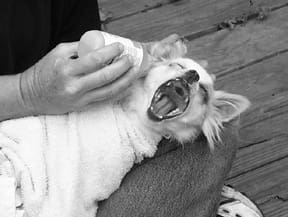
Hearing Loss and Deafness
There are a number of factors involved in hearing loss and deafness: infections; trauma and loud noises; many drugs; old age; genetic susceptibility; neural damage; etc. The most common form of hearing loss is called “conductive” hearing loss and it is caused by a blockage of the ear canal – from foreign bodies, infections, or an excessive buildup of cerumen (earwax).
Exposure to loud noises can cause “sensory” hearing loss, and this loss becomes progressively worse as the exposure continues over time. Dogs who are subjected to loud rock or rap music (and no animal should suffer this kind of torture!) will gradually lose their hearing, and the loss can be permanent. Quick impact, high-level noise such as gunshots can also cause hearing loss, and it has been recommended that hunting dogs wear ear plugs, much as the hunter does.
There are many drugs that can cause hearing loss, including aminoglycoside anti-biotics such as gentamycin and amikacin; loop diuretics such as furosemide (Lasix); several anti-cancer drugs; and even high doses of aspirin. Be sure to check with your vet before any drugs are used – to be sure they will not cause hearing loss (and to be sure your vet has actually read the package insert for the drug ).
Diseases such as diabetes, kidney failure, and hypothyroidism may be associated with hearing loss.
As a dog ages, much like his human counterpart, his hearing diminishes. The first signs of hearing loss may be a hesitation to obey commands, or a reluctance to go into strange territory. Old age hearing loss is usually a slow, progressive change, and you may be able to slow it somewhat with good nutrition, antioxidants, and adding some ginkgo to the diet.
An old dog may initially lose only the ability to hear certain frequencies (usually in the upper ranges), so speaking to him in low tones may be helpful. Some people have found that percussive sounds such as clapping can be heard by fairly deaf dogs, so they clap to draw the dog’s attention to hand signals. Realize, too, that hearing loss can create behavioral changes – some old dogs can be startled easily and may snap or bite when surprised.
“Neural” hearing loss is the least common form, and it can be caused by head trauma, blood clots or ruptured blood vessels, or brain tumors.
There is a test called the BAER (Brain Auditory Evoked Response) test that will accurately record hearing loss, and it can be used to detect partial loss, unilateral hearing loss, and total, bilateral deafness. This test is especially beneficial for testing puppies of breeds known to have a high incidence of deafness. Check with your veterinarian for more information.
Dr. Randy Kidd earned his DVM degree from Ohio State University and his Ph.D. in Pathology/Clinical Pathology from Kansas State University. A past president of the American Holistic Veterinary Medical Association, he’s author of Dr. Kidd’s Guide to Herbal Dog Care and Dr. Kidd’s Guide to Herbal Cat Care.


